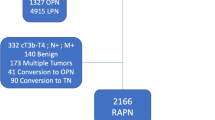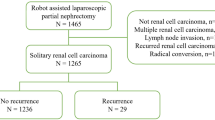Abstract
Surgery remains the only treatment with a chance of cure for renal cell carcinoma. Laparoscopic radical nephrectomy (LRN) has developed to be a standard treatment for the management of suspected renal malignancy in many centers worldwide, with oncologic efficacy equal to that of open radical nephrectomy. LRN has considerable advantages over open surgery, such as decreased postoperative morbidity, decreased analgesic requirements, and shorter hospital stay and convalescence. Current indications for LRN include all patients with localized stage T1–2 renal tumors. LRN for stage T3 renal tumors may be technically feasible in individual situations, but cannot be considered standard treatment. Open radical nephrectomy is reserved for advanced renal tumors, according to the surgeon's judgment. Partial nephrectomy is well established and considered to be the standard management for all organ-confined tumors of ≤4 cm in diameter. The scope of partial nephrectomy, however, is expanding, and now includes patients with organ-confined renal tumors of ≤7 cm. Laparoscopic partial nephrectomy is a continuously evolving technique. Continuing developments allow the experienced laparoscopist to use laparoscopic surgery for virtually all patients who are eligible for elective partial nephrectomy. This review evaluates the current indications and contraindications for laparoscopic radical and partial nephrectomy.
Key Points
-
Surgery provides the only chance of cure for patients with renal cell carcinoma, and the type of surgery offered to patients is dependent on the size, location and stage of the tumor, and the general condition of the patient
-
Compared to open radical nephrectomy, laparoscopic radical nephrectomy offers patients improved postoperative morbidity, shorter hospital stay and recovery time, and decreased need for analgesia
-
Laparoscopic radical nephrectomy is the standard treatment of renal tumors >4 cm in size, of clinical stage T1–2 N0 M0, and can be performed in some T3 tumors (depending on the clinical evaluation of the patient and Sargon's experience); for large tumors a transperitoneal approach is both easier and safer than a retroperitoneal approach
-
Laparoscopic partial nephrectomy performed under ischemia is feasible and effective for the treatment of organ-confined renal tumors of ≤4 cm in diameter
This is a preview of subscription content, access via your institution
Access options
Subscribe to this journal
Receive 12 print issues and online access
$209.00 per year
only $17.42 per issue
Buy this article
- Purchase on Springer Link
- Instant access to full article PDF
Prices may be subject to local taxes which are calculated during checkout
Similar content being viewed by others
References
Hunt JD et al. (2005) Renal cell carcinoma in relation to cigarette smoking: meta-analysis of 24 studies. Int J Cancer 114: 101–108
Kawamura K et al. (2000) Acquired renal cystic disease. Hinyokika Kiyo 46: 651–656
Zhuang Z et al. (1996) Detection of von Hippel–Lindau disease gene mutations in paraffin-embedded sporadic renal cell carcinoma specimens. Mod Pathol 9: 838–842
Portis AJ et al. (2002) Long-term followup after laparoscopic radical nephrectomy. J Urol 167: 1257–1262
Fergany AF et al. (2000) Long-term results of nephron sparing surgery for localized renal cell carcinoma: 10-year followup. J Urol 163: 442–445
Hafez KS et al. (1999) Nephron sparing surgery for localized renal cell carcinoma: impact of tumor size on patient survival, tumor recurrence and TNM staging. J Urol 162: 1930–1933
Allaf ME et al. (2004) Laparoscopic partial nephrectomy: evaluation of long-term oncological outcome. J Urol 172: 871–373
Manikandan R et al. (2004) Which is the real gold standard for small-volume renal tumors? Radical nephrectomy versus nephron-sparing surgery. J Endourol 18: 39–44
Robson CJ (1963) Radical nephrectomy for renal cell carcinoma. J Urol 89: 37–42
Frank I et al. (2005) Independent validation of the 2002 American Joint Committee on Cancer primary tumor classification for renal cell carcinoma using a large, single institution cohort. J Urol 173: 1889–1892
Lightfoot N et al. (2000) Impact of noninvasive imaging on increased incidental detection of renal cell carcinoma. Eur Urol 37: 521–527
Herr HW (1999) Partial nephrectomy for unilateral renal carcinoma and a normal contralateral kidney: 10-year followup. J Urol 161: 33–34
Patard JJ et al. (2004) Safety and efficacy of partial nephrectomy for all T1 tumors based on an international multicenter experience. J Urol 171: 2181–2185
Clayman RV et al. (1991) Laparoscopic nephrectomy: initial case report. J Urol 146: 278–282
Allan JD et al. (2001) Laparoscopic radical nephrectomy. Eur Urol 40: 17–23
Janetschek G et al. (2002) Laparoscopic tumor nephrectomy [German]. Urologe A 41: 101–106
Wille AH et al. (2004) Laparoscopic radical nephrectomy: techniques, results and oncological outcome in 125 consecutive cases. Eur Urol 45: 483–889
Nambirajan T et al. (2004) Prospective, randomized controlled study: transperitoneal laparoscopic versus retroperitoneoscopic radical nephrectomy. Urology 64: 919–924
Winfield HN et al. (1993) Laparoscopic partial nephrectomy: initial case report for benign disease. J Endourol 7: 521–526
Janetschek G et al. (1998) Laparoscopic nephron sparing surgery for small renal cell carcinoma. J Urol 159: 1152–1155
Gill IS et al. (2002) Laparoscopic partial nephrectomy for renal tumor: duplicating open surgical techniques. J Urol 167: 469–467
Singh D et al. (2005) Laparoscopic partial nephrectomy. J Endourol 19: 451–455
Gill IS et al. (2003) Comparative analysis of laparoscopic versus open partial nephrectomy for renal tumors in 200 patients. J Urol 170: 64–68
Beasley KA et al. (2004) Laparoscopic versus open partial nephrectomy. Urology 64: 458–461
Abukora F et al. (2005) Laparoscopic nephron sparing surgery: evolution in a decade. Eur Urol 47: 488–493
Gill IS et al. (2003) Laparoscopic ice slush renal hypothermia for partial nephrectomy: the initial experience. J Urol 170: 52–56
Janetschek G et al. (2004) Laparoscopic partial nephrectomy in cold ischemia: renal artery perfusion. J Urol 171: 68–71
Landman J et al. (2003) Renal hypothermia achieved by retrograde endoscopic cold saline perfusion: technique and initial clinical application. Urology 61: 1023–1025
Guillonneau B et al. (2003) Laparoscopic partial nephrectomy for renal tumor: single center experience comparing clamping and no clamping techniques of the renal vasculature. J Urol 169: 483–486
Fugita OE et al. (2004) Laparoscopic radical nephrectomy in obese patients: outcomes and technical considerations. Urology 63: 247–252
Kapoor A et al. (2004) Comparison of laparoscopic radical renal surgery in morbidly obese and non-obese patients. J Endourol 18: 657–660
Klingler HC et al. (2003) Benefits of laparoscopic renal surgery are more pronounced in patients with a high body mass index. Eur Urol 43: 522–527
Anast JW et al. (2004) Differences in complications and outcome for obese patients undergoing laparoscopic radical, partial or simple nephrectomy. J Urol 172: 2287–2291
Reedy MB et al. (1997) Laparoscopy during pregnancy: a study of five fetal outcome parameters with use of the Swedish Health Registry. Am J Obstet Gynecol 177: 673–679
Sainsbury DC et al. (2004) Laparoscopic radical nephrectomy in first-trimester pregnancy. Urology 64: 1231
Desai MM et al. (2003) Laparoscopic radical nephrectomy for cancer with level I renal vein involvement. J Urol 169: 487–491
Disanto V et al. (2005) Retroperitoneal laparoscopic radical nephrectomy for renal cell carcinoma with infrahepatic vena caval thrombus. Eur Urol 47: 352–356
Desai MM et al. (2005) The impact of warm ischaemia on renal function after laparoscopic partial nephrectomy. BJU Int 95: 377–383
Bhayani SB et al. (2004) Laparoscopic partial nephrectomy in patients with neoplasia in a solitary kidney. Urology 64: 35–37
Flanigan RC et al. (2001) Nephrectomy followed by interferon alfa-2b compared with interferon alfa-2b alone for metastatic renal-cell cancer. N Engl J Med 345: 1655–1659
Mickisch GH et al. (2001) Radical nephrectomy plus interferon-alfa-based immunotherapy compared with interferon alfa alone in metastatic renal-cell carcinoma: a randomised trial. Lancet 358: 966–970
Rabets JC et al. (2004) Laparoscopic versus open cytoreductive nephrectomy for metastatic renal cell carcinoma. Urology 64: 930–934
Joslyn SA et al. (2005) Impact of lymphadenectomy and nodal burden in renal cell carcinoma: retrospective analysis of the National Surveillance, Epidemiology, and End Results database. Urology 65: 675–680
Janetschek G et al. (2001) Laparoscopic retroperitoneal lymph node dissection. J Endourol 15: 449–453
Author information
Authors and Affiliations
Corresponding author
Ethics declarations
Competing interests
The authors declare no competing financial interests.
Rights and permissions
About this article
Cite this article
Albqami, N., Janetschek, G. Indications and contraindications for the use of laparoscopic surgery for renal cell carcinoma. Nat Rev Urol 3, 32–37 (2006). https://doi.org/10.1038/ncpuro0384
Received:
Accepted:
Issue Date:
DOI: https://doi.org/10.1038/ncpuro0384
This article is cited by
-
Prolonged international normalized ratio and vascular injury at divisional level predict embolization failures of patients with iatrogenic renal vascular injuries
Scientific Reports (2019)
-
Caregivers’ information needs and their ‘experiences of care’ during treatment are associated with elevated anxiety and depression: a cross-sectional study of the caregivers of renal cancer survivors
Supportive Care in Cancer (2016)
-
Aktuelle chirurgische Aspekte des Nierenzellkarzinoms
Wiener Medizinische Wochenschrift (2009)
-
Strategies in the management of renal tumors amenable to partial nephrectomy
Surgical Endoscopy (2009)
-
Laparoskopische oder offene Tumornephrektomie und Nierenteilresektion
Der Urologe (2007)



